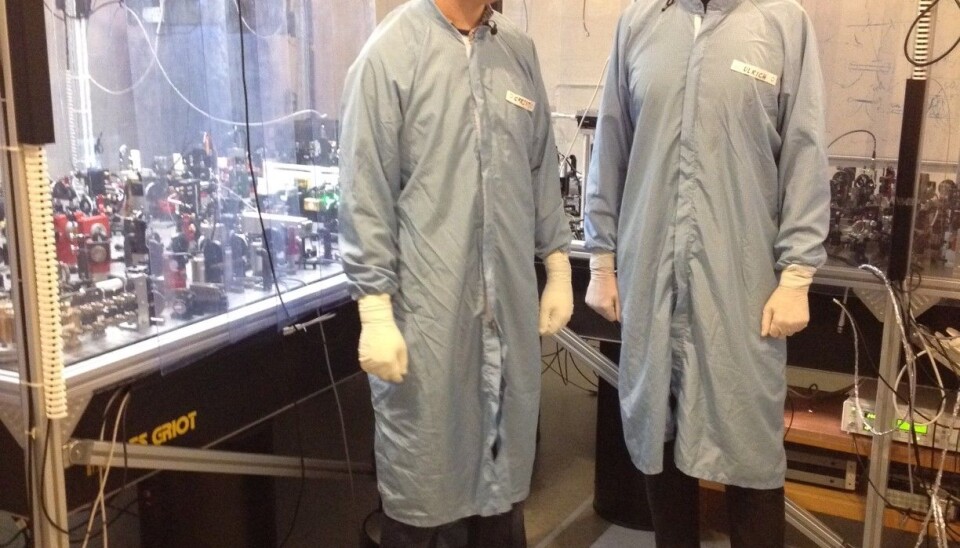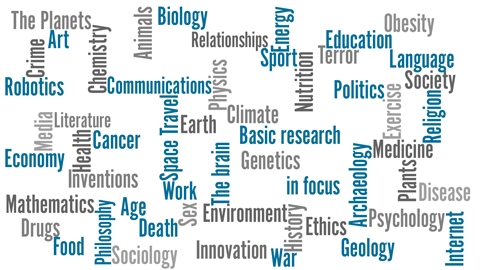
Hunting for the “quantum limit”
Lasers, encryption, and the boundaries of “reality.” Follow ScienceNordic as we enter the world of quantum physics.
Dressed in blue coats, dark goggles, hairnets, white clogs, and rubber gloves, two physicists enter the quantum laboratory in the basement of the Technical University of Denmark (DTU) Physics department.
At about two meters wide, the L-shaped table in front of them is covered with a peculiar arrangement resembling a futuristic-looking LEGO town of black, grey, and red glass and metal components protruding from the surface at different angles. Some components resemble a magnifying glass, others are just metal boxes with small holes and a multitude of connecting wires extending out of them.
Between all of these, an invisible quantum mechanical dance is taking place, orchestrated by the two physicists Ulrich Busk Hoff and Christian Scheffmann Jacobsen, post docs in quantum physics at DTU.
“My part of the set up is running right now, but you can’t see it. You can only see it on the computer here,” says Jacobsen, and points to a display suspended next to the table. A green and yellow line fiercely vibrates on the screen, indicating that something is stirring down there on the table.
A hidden world of lasers
Jacobsen says the lines on the screen indicate the quantum state of the light bouncing between the mirrors in the experimental setup.
Like a director of a flea circus, he points to the various components on the table.
“If you just look carefully over your goggles, you can clearly see the green laser,” says Jacobsen. He pushes the safety glasses down a bit to look across the experiment.
I follow his example and the quantum experiment immediately springs to life as emerald light shoots out from a box in the corner, zigzagging across the table like it was a pinball machine.
But my opportunity for amazement is short-lived.
“The laser is so powerful that you can become partially blind if the beam gets in your eye,” says Hoff.
So after a quick glimpse of the laser, the goggles go back up and the room once again appears dim.
“Think of photons as hail on a tin roof”
But it is not the green laser the scientists are interested in. It solely serves as a source of energy that kick-starts the actual quantum experiment.
“Right now, the system is measuring the quantum state of an infrared light beam, which we produce by converting energy from the green laser,” says Jacobsen.
He points to a small hole in a grey metal box at the end of the table, which is where the infrared light is absorbed and measured, before it ends up as the vibrating lines on the computer display.
The vibrations are referred to as ‘noise’ and reflect fluctuations in light.
The trip from mirror to mirror corrects the light in such a way that it creates a more “orderly” beam of light that can be measured, says Jacobsen.
“You can think of photons [light] as hail falling on a tin roof. If the hail isn’t ordered, then it lands randomly and the noise that appears is also random. Our process in the experimental set-up sorts the hail so that it lands in pairs, which gives a more ordered image of the noise,” he says.
Paired photons could be used for encryption
Jacobsen measures how the photon pairs interact with each other in the ordered part of the infrared light. This allows him a peek at the photons’ amplitude and phase, which is an expression of the noise of the laser beam.
But it is a difficult exercise, as a fundamental principle in quantum mechanics dictates that it is impossible to define both simultaneously.
“You cannot know both the amplitude and phase of the photons at the same time. Never. If you know one, you don’t know the other,” says Jacobsen.
Not that this is a problem. On the contrary, this condition can be exploited, which is precisely what Jacobsen is trying to do. He has just published a new study based on this.
“We can use that knowledge to make quantum encryption of information. If I want to send a message through light, unauthorised people cannot know how the information in my message is divided between the amplitude or the phase. Thus, they may only receive a portion of the message, but never the whole picture,” he says.
Investigating the boundary between micro and macro
The experimental setup in the quantum laboratory consists of five individual experiments, including Jacobsen’s quantum encryption experiment.
Hoff also has an experiment in the works, which is part of a larger project that aims to explain why the macro world that we inhabit does not behave in the same way as the quantum world.
“Or why your wardrobe cannot be in two places at once,” says Hoff.
He points to a second display with an image of a black and white structure that resembles a lopsided mushroom.
Hoff points to a plate underneath the camera that transmits the picture of the “mushroom.”
“There’s actually a whole row of them [mushrooms shapes]—they’re made of glass and are 60 micrometres wide—you can just about discern them with the naked eye,” he says.
“The glass ‘mushrooms’ swing up and down, which we measure with the help of laser light. We try to cool them down to their quantum mechanical state by changing the light,” he says.
Searching for the “quantum limit”
The scientists will use this technique in a new experiment, in which they try to get another object, this time consisting of a few billion atoms, to be in two places simultaneously.
“It will help us to understand what it is that makes us not experience these types of quantum superpositions with everyday things, such as furniture,” says Hoff.
He imagines that there is a smooth transition between quantum mechanical and non-quantum mechanical behaviour.
“It would be very non-physical, if there just was an abrupt boundary. But we’ll have to wait and see,” says Hoff.
------------------
Read the full story in Danish on Videnskab.dk
Translated by: Catherine Jex





